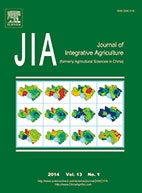|
|
Soil Quality Assessment of Acid Sulfate Paddy Soils with Different Productivities in Guangdong Province, China
LIU Zhan-jun, ZHOU Wei, SHEN Jian-bo, LI Shu-tian, LIANG Guo-qing, WANG Xiu-bin, SUN Jing-wen , AI Chao
2014, 13(1):
177-186.
DOI: 10.1016/S2095-3119(13)60594-8
Land conversion is considered an effective measure to ensure national food security in China, but little information is available on the quality of low productivity soils, in particular those in acid sulfate soil regions. In our study, acid sulfate paddy soils were divided into soils with high, medium and low levels based on local rice productivity, and 60 soil samples were collected for analysis. Twenty soil variables including physical, chemical and biochemical properties were determined. Those variables that were significantly different between the high, medium and low productivity soils were selected for principal component analysis, and microbial biomass carbon (MBC), total nitrogen (TN), available silicon (ASi), pH and available zinc (AZn) were retained in the minimum data set (MDS). After scoring the MDS variables, they were integrated to calculate a soil quality index (SQI), and the high, medium and low productivity paddy soils received mean SQI scores of 0.95, 0.83 and 0.60, respectively. Low productivity paddy soils showed worse soil quality, and a large discrepancy was observed between the low and high productivity paddy soils. Lower MBC, TN, ASi, pH and available K (AK) were considered as the primary limiting factors. Additionally, all the soil samples collected were rich in available P and AZn, but deficient in AK and ASi. The results suggest that soil AK and ASi deficiencies were the main limiting factors for all the studied acid sulfate paddy soil regions. The application of K and Si on a national basis and other sustainable management approaches are suggested to improve rice productivity, especially for low productivity paddy soils. Our results indicated that there is a large potential for increasing productivity and producing more cereals in acid sulfate paddy soil regions.
|
